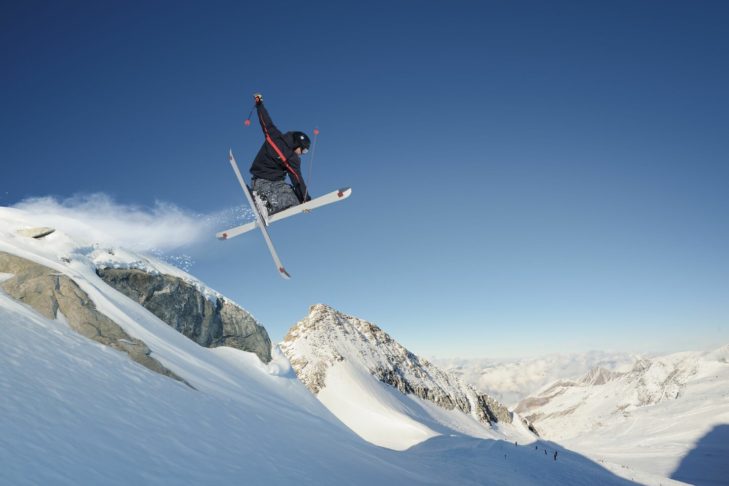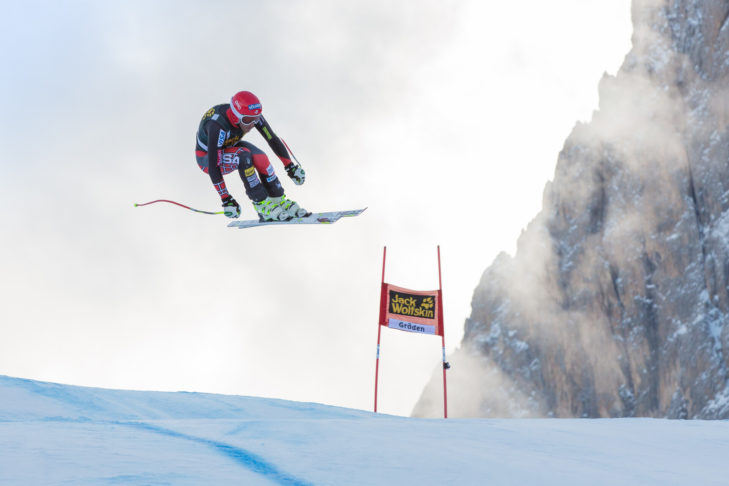For many people, skiing or snowboarding is their favourite leisure activity. Despite all the euphoria, not only experienced skiers indulge in the thrill of speed on the piste. It is not uncommon to reach speeds that you would normally first hit when driving, which can result in a serious crash on the descent. With the help of an expert, SnowTrex explains how skiers can protect themselves, for example using a back protector, should worst come to worst.
A true expert on back protectors
SnowTrex spoke to Thomas Gabriel about the topic of back protectors. As a passionate skier and snowboarder, he has turned his hobby into his profession and is responsible for the press and editorial departments at helmexpress.com, a provider of winter sports clothing.
Back protectors don’t have to be expensive
Mr Gabriel, don’t back protectors restrict freedom of movement?
It wasn’t so long ago that back protectors were rather unpopular with winter sports enthusiasts due to their weight and bulky shape, as they actually mainly restricted freedom of movement. Modern back protectors, on the other hand, still have their protective properties, but today they are made of much more flexible and lighter materials that allow full freedom of movement and are hardly noticeable in terms of weight. Back protectors for snowboarders, skiers and cross-country skiers are not only highly recommended but also inexpensive equipment. Basic models are available starting around 30 euros.
What is the difference between hard and soft protectors?
The additional labels “hard” and “soft” already provide information about the key characteristics of the two different groups of protectors. Soft protectors are usually designed as waistcoats with a zip, which have additional padding in the back area. Depending on the model, this padding can extend from the neck down to the tailbone. Soft protectors should be worn directly over your base layer of garments in order to have the closest possible contact with the body. This is the only way to optimally absorb the impact energy during a fall.
Hard protectors, on the other hand, consist of solid plastic plates that function like a protective shield. This type of back protector consists of several interconnected elements. They are equipped with chest, shoulder and hip straps and can also be worn over ski overalls or ski jackets. Hard protectors are mainly suitable for skiers and snowboarders who reach high speeds on their descents. The hard materials prevent sharp branches or ski poles from penetrating in the event of a fall, while the plastic effectively absorbs the impact energy and prevents extensive abrasions.#
What should people looking to buy a back protector for winter sports pay attention to?
A snug fit of the back protector is essential for effective protection. If the protectors slip out of place, this could not only impair back protection, but also the athlete’s freedom of movement. This risk does not usually exist with soft protectors. Nevertheless, just like hard protectors, they should definitely be tried on before buying. They should be neither too loose nor too tight. With hard protectors, this can of course be adjusted using the adjustable belts.
In addition to the protective effect, wearing comfort is the top priority. With hard protectors, for example, you can check whether the individual elements have a certain amount of flexibility so that they adapt to the contours of the body. Ventilation is also a must. In the case of soft protectors, breathable fabrics in the cover and padding ensure appropriate air circulation.
Back protector manufacturers must comply with EU standards
Are there any regulations that manufacturers have to comply with?
Just like with ski helmets, there is an EU standard for back protectors that ensures that the products fulfil the requirements. For ski helmets, this is standard EN 1621-1 (2). The most important point in EN 1621-1 (2) is the absorption of impact energy. The standard specifies several impact tests that the respective model must pass in order to fulfil the standard requirements. The basis for EN 1621-1 (2) is experience from motorbike racing, for which this standard was originally created. It was only later that it was extended to winter sports. As with ski helmets, back protectors are also divided into two protection classes, which correspond to the respective hazard potential.
How long does a back protector last?
Like almost all common plastics, the components of back protectors are also subject to the effects of UV radiation and cold. Two things that are increasingly common in winter sports resorts. It is advisable to replace a back protector after about 5 to 7 years. When the back protector is not in use, it should be stored away from light and cold, for example in a sports bag.
Want to find out more about ski gear? Click here for a brief lesson on ski equipment.
FAQ’s on back protectors
What are back protectors?
Back protectors help to stabilise the back when skiing or snowboarding and protect it, especially in the event of a fall. Manufacturers differentiate between soft and hard protectors. Soft protectors are padded waistcoats with a zip at the back, while hard protectors are made of solid plastic plates.
If I’m skiing, do I need a back protector?
Back protectors are not compulsory on the piste. However, thanks to their stabilising effect and protective function, they can give winter sports enthusiasts a safer feeling on the slopes and effectively protect important parts of the body in the event of a fall. Skiers and snowboarders who like it fast should therefore always use a back protector.
Who are hard protectors suited for? And soft?
Hard protectors are mainly suitable for skiers and snowboarders who like to go fast. Soft protectors, on the other hand, are suitable for all those who want extra protection for their back on the piste.
Do back protectors restrict freedom of movement?
These days, modern back protectors are also manufactured with comfort and wearability in mind. The fact that manufacturers are using ever more flexible and lighter materials for their products means that freedom of movement has been increased, while the protective function remains extremely high.
How much does a back protector cost?
If you are looking for an affordable back protector, you can buy high-quality models for as little as 30 euros. As with so many ski products, the price is of course wide open on the upper end.
Where can you buy a back protector?
The best place for skiers and snowboarders to buy a back protector is at their local sports retailer, where they can get advice from competent staff and try out different models. Back protectors can also be purchased online directly from the manufacturers. However, it is advisable to read test reports from reliable sources beforehand to be well-informed.







